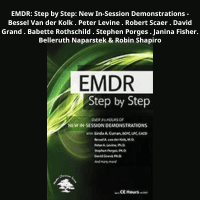Course Summary:
“EMDR: Step by Step: New In-Session Demonstrations” is a unique and invaluable resource for learning and refining EMDR (Eye Movement Desensitization and Reprocessing) therapy techniques. This masterclass brings together a panel of the world’s leading experts in trauma treatment, including Bessel van der Kolk, Peter Levine, Robert Scaer, David Grand, Babette Rothschild, Stephen Porges, Janina Fisher, Belleruth Naparstek, and Robin Shapiro. The core of the course lies in its extensive use of new, real in-session demonstrations, providing viewers with a clear and practical understanding of how to implement each step of the EMDR protocol effectively. These demonstrations showcase various approaches and nuances in working with different client presentations and trauma experiences. The course aims to bridge the gap between theoretical knowledge and practical application, making EMDR accessible and implementable for both beginners and experienced clinicians.
Target Audience:
This program is essential for:
- Therapists, psychologists, counselors, and social workers seeking comprehensive EMDR training.
- EMDR-trained clinicians looking to deepen their understanding and refine their techniques through real-world examples.
- Trauma therapists interested in learning diverse approaches to EMDR from leading experts in the field.
- Students and interns in mental health disciplines seeking a practical introduction to EMDR therapy.
- Anyone interested in understanding the step-by-step process of EMDR as demonstrated by masters in the field.
Main Content:
The course likely covers key areas such as:
- The Foundational Principles of EMDR: A review of the theoretical underpinnings and adaptive information processing model of EMDR.
- The Eight Phases of EMDR Therapy: Detailed step-by-step demonstrations of each phase, including:
- Phase 1: History-taking and Treatment Planning: Observing how experts gather client history and identify target memories.
- Phase 2: Preparation: Demonstrations of client preparation, establishing safety and resourcing.
- Phase 3: Assessment: Witnessing the activation of target memories and assessment of related cognitions, emotions, and body sensations.
- Phase 4: Desensitization: Observing various bilateral stimulation techniques and the processing of traumatic memories.
- Phase 5: Installation: Demonstrations of how to strengthen positive cognitions.
- Phase 6: Body Scan: Learning how to address residual somatic distress.
- Phase 7: Closure: Observing effective techniques for ending a session.
- Phase 8: Re-evaluation: Understanding how to assess treatment progress.
- Nuances and Variations in EMDR Techniques: Observing different approaches to bilateral stimulation, cognitive interweaves, and managing abreactions.
- Working with Specific Populations and Trauma Types: Demonstrations may showcase adaptations of EMDR for complex trauma, attachment issues, and other specific challenges.
- Expert Insights and Commentary: The featured experts likely provide commentary and explanations during and after the demonstrations, highlighting key considerations and best practices.
- Integrating EMDR with Other Therapeutic Modalities: While the focus is on EMDR, some experts may touch upon how it can be integrated with other therapeutic approaches.
Without the specific sale page link, this summary is based on the likely content of a course featuring such a distinguished panel of EMDR experts and emphasizing in-session demonstrations. If you can provide the sale page link, I can refine the summary further.
Learn EMDR from the masters with real in-session demonstrations!
SIGN UP NOW












